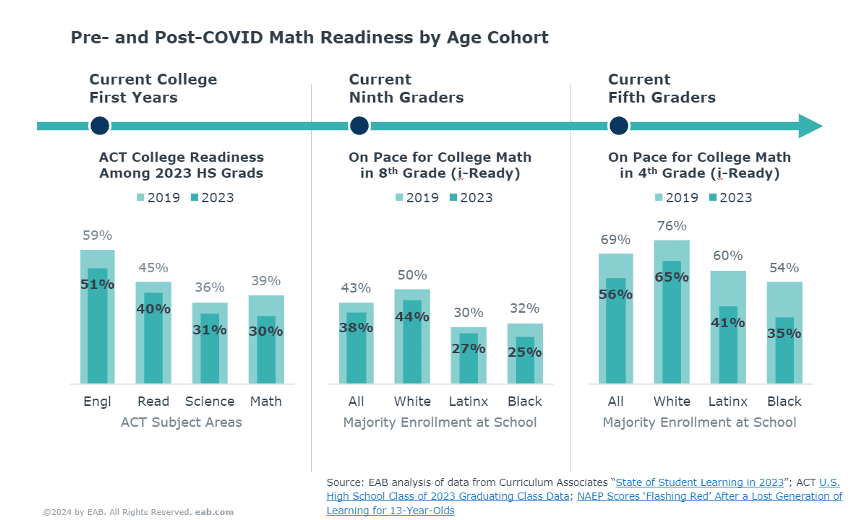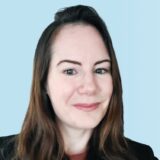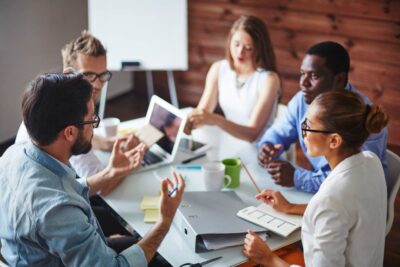The student readiness crisis: 4 ways community colleges can use technology to counter growing student readiness gaps
Through interviews with dozens of campus leaders and industry experts, we’ve learned that the effects of K-12 pandemic disruptions—such as chronic absenteeism, declining reading and math skills, and widespread classroom disengagement—have already begun to appear on community college campuses. In fact, a recent EAB survey showed that 44% of high school students considering community college are motivated by the desire to prepare academically for a four-year college, suggesting they feel unready for the rigors of a college classroom.
While this is concerning, what’s even more alarming is that the most significant impacts of the student readiness challenge are still ahead. Students who were in elementary school during the pandemic are unlikely to fully recover academically by the time they reach college in the next 3 to 5 years. To address the needs of this coming generation, community colleges must prepare now for a wave of underprepared learners.
The good news for community colleges is that they are built for this challenge. This sector has decades of experience, research, and field-tested practices dedicated to supporting underprepared students which can be used to prepare for the upcoming influx of students who will need additional help. Combining these proven best practices with technology can help scale your institution’s response to the growing need for intensive support.
What do we know about academic and socio-emotional readiness gaps?
Grade school students are seeing historic drops in reading and math attainment. The National Assessment of Educational Progress (NAEP), often regarded as the nation’s educational “report card,” shows that two-thirds of American students lack proficiency in reading. If students haven’t mastered reading by third grade, they are more likely to struggle in all of their subjects.
- 67% of 4th graders weren’t proficient in reading in 2022, up 2% from 2019
- 69% of 8th graders weren’t proficient in reading in 2022, up 3% from 2019
Math scores, which strongly predict long-term student success, have suffered the most since the pandemic. Both ACT and I-Ready math benchmarks, indicators of students’ preparedness for college-level math, have significantly dropped.

In addition to academic readiness challenges, younger students are struggling with socioemotional skills and battling against increasing mental health concerns. More than 80% of public schools have observed stunted behavioral and socioemotional development in students due to the pandemic, with 69% seeing an increase in students seeking mental health services.
Additionally, the CDC’s 2021 Youth Risk Surveillance Report shows significant increases in students reporting feelings of sadness, hopelessness, and serious consideration of suicide compared to a decade earlier, indicating an immediate need for mental health interventions.
Community colleges are already reporting these academic and socio-emotional stressors are showing up on campus through students:
- Being disengaged in the classroom and struggling to complete their coursework
- Increasingly asking for extensions and alternate assignments
- Struggling with healthy communication and relationships
- Having diminished executive function skills, like problem solving and critical thinking
- Increasing demands for tutoring and academic support
- Having difficulty with stress management
-
42%
of ACT-tested 2022 HS grads met none of the college-readiness subject benchmarks in English, reading, science and math
How can community colleges use technology to scale their student readiness response?
In the coming years, more students may need academic and socio-emotional support, but it’s unlikely that colleges will have additional staff to meet the increased demand. To address this bandwidth gap, community colleges can use technology to efficiently identify and support underprepared learners, enabling scalable interventions that address both academic and socio-emotional needs. This proactive approach helps improve student retention and success rates, better equipping colleges to handle a rapid influx of underprepared students.
Here are four ways that community colleges can use technology to help respond to student readiness gaps:
- Relationship-driven recruitment and onboarding systems
- Tiered early interventions in math
- Modernizing tutoring appointment scheduling
- Identify early-stage mental and emotional health concerns
Relationship-driven recruitment and onboarding systems
A relationship-driven recruitment and onboarding process at community colleges can deliver personalized support to help underprepared students navigate their transition to college. Offering tailored guidance and resources from the outset helps address individual needs and build a foundation for academic success.
Using technology to offset administrative tasks that are manual, repetitive, and high volume frees up recruitment teams to have deeper conversations with students. Tech-enable your recruitment and onboarding pipeline with:
- Intuitive inquiry forms: Students who are apprehensive about college may be hesitant to complete a long admissions form. Prioritizing short inquiry forms allows students to have a “quick start” with your college and lowers the barrier to receiving personalized outreach.
- Messaging campaigns: Tailored messaging campaigns guide students through their unique onboarding steps and educate them about the college’s culture, academic resources, and social supports. Campaigns can be scaled to reach large groups of students while still feeling like they have a personal touch.
- Onboarding surveys: By asking prospective students about their biggest concerns or areas where they feel least prepared for college, you can provide support before they even register for classes.
- Data analysis: Having systems in place to identify prospective students who may be less prepared for college enables your team to allocate more support to those with the highest need.
Tiered early interventions in math
As K-12 students underperforming in math transition to community college, it’s crucial to revisit and align math supports to meet their needs. Community colleges have a tradition of offering tailored math interventions, such as tutoring and supplemental instruction. However, now is the time to ensure these supports are integrated in a coordinated, scalable manner.
Early alerts aren’t a new concept but implementing them within the first week of the semester might be unfamiliar to some. In traditional early alert models, students might receive an alert when midterm grades are released—but for many students, that’s too late in the semester for interventions to make a difference.
Broward College uses Navigate360 to issue early alerts in developmental math three times throughout the semester, beginning when students struggle on an ungraded test during the first week of class.

Additional alerts are triggered based on exam scores and grades as the semester progresses. Students who receive an alert are routed not only to an academic advisor but also to the financial aid office to understand the consequences of failing or withdrawing from the class. By establishing multiple touchpoints and initiating them earlier, students who receive an intervention have a course pass rate (a ‘C’ or better) that is 4-9% higher than their peers.
This model allows colleges to provide steady support throughout the semester, rather than overwhelming advisors with a large volume of requests all at once. As more students arrive with readiness gaps in reading and math, these early, scalable, and trackable interventions will be pivotal in keeping them on track.
Read more about Broward College’s developmental math early intervention strategy
Modernized tutoring appointment scheduling
Even though community colleges offer tutoring, not all take advantage of it. By streamlining the sign-up process, providing appointment reminders, and allowing digital adjustments to tutoring schedules, colleges can increase tutoring usage while collecting important data on who is using tutoring, at what times, and which courses have the most tutoring requests. As readiness gaps become more pronounced and the demand for tutoring increases, the ability to service higher volumes of students in a systematic way will become pivotal.
Arapahoe Community College increased their tutoring usage fourfold in two years by making appointment scheduling more user-friendly. Students can now schedule tutoring appointments directly through the Navigate360 app, allowing advisors to track how often they attend tutoring and what subjects they receive help in. Additionally, tech-enabled scheduling allows students to sit with a faculty member or advisor and schedule an appointment together in real time, rather than relying on the student to contact the tutoring department on their own.

Lastly, modernizing appointment scheduling also gives the tutoring center data they can use to adjust staffing as needed, ensuring students don’t face long wait times for appointments.
Recognizing early-stage mental and emotional health concerns
Community colleges have long supported students dealing with stressful life circumstances, trauma, and mental health needs, but obstacles such as social stigma, resource shortages, and inefficient care coordination can hinder effective support. As more students experience mental health and wellbeing stressors, using technology to identify these needs before they escalate can reduce the number of students in crisis and enhance the scalability of outreach efforts.
Ways to use technology to identify mental health and wellbeing barriers early include:
- Onboarding Surveys: Screen students about their stress management, emotional health, and concerns for the upcoming semester to identify those needing additional support, including graduate students.
- Mid-Semester Check-ins: Conduct short “pulse check” surveys at various points in the year to support students overwhelmed by academic and social demands. Navigate360’s survey tools make it easy for students to respond to surveys from their phone.
- “Hand raise” options: Having systems in place that allow students to raise a virtual hand when something is wrong can ensure they receive help promptly.
- Streamline mental health referral systems: Make it easy for anyone on campus to refer students to a designated liaison that can connect them with resources.
Technology like Navigate360 can play a crucial role in preparing community colleges to support underprepared learners by enabling early alerts, coordinated care, proactive messaging, and the collection of data on the effectiveness of interventions.
Get started with technology-enabled readiness support
Fill out the form to request a demo.

More Blogs

Four signs it’s time to break up with your student CRM

Three lessons from 1,200 student success leaders on higher ed’s future
